More events of Tuesday 6th May 2014
Introduction
When I arrived at Sittwe by air on 3rd May 2014 (described in the post On to Mrauk U), we simply drove along the Main Road through the town to the boat yard where I embarked for the trip up the Kaladan River to Mrauk U.
On 6th May 2014, I returned from Mrauk U to Sittwe by boat and this journey is described here. However, on this occasion there was time to see a little of Sittwe before catching my flight back to Yangon.
Mrauk U had been the capital of the Rakhine state for centuries and, initially, the British had a presence there. But the British decided to develop Sittwe (or 'Sittway' as they spelt the name) as their Adminstrative Centre, accelerating the decline of Mrauk U.
The influence of the British is still visible. Most of the development took place along a long, straight thoroughfare parallel to the shore called 'Main Road'. A number of the buildings, even today, clearly show British architectural ideas.
The Merchant's House
We entered the forecourt of a large house set back from the road. The design was generally 'British Colonial Villa', although the arched windows gave a rather ecclesiastical appearance. The building was topped by two gilded spires of Burmese design which I assumed were a later addition.
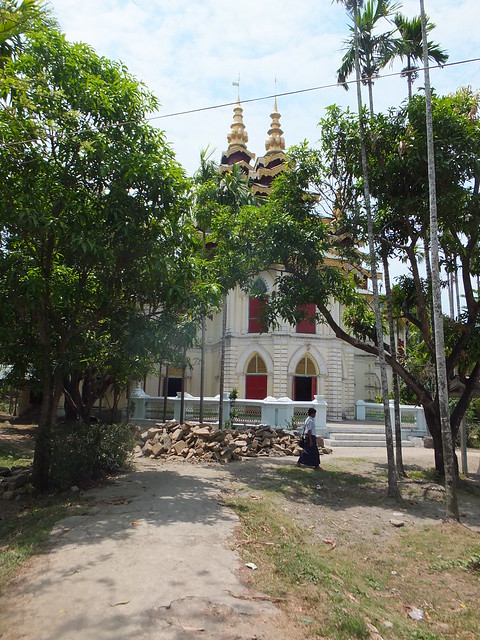
Merchant's House in Sittwe.
During the British period, certain people did very well from the trade opportunities and this house had been the home of a businessman of, I think, Indian origin who died in 1911. A rather austere photograph of the merchant hangs on the wall.
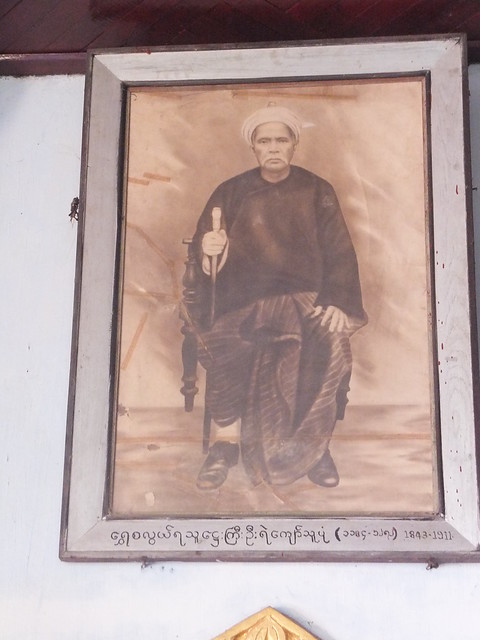 The Sittwe Merchant.
The Sittwe Merchant.
I believe the merchant bequeathed the house to the people of Sittwe and appears to be currently part of a Buddhist temple. The ground floor of the building formed single, large room, with a number of columns supporting the upper floor. I was intrigued that each column was formed from two substantial rolled steel 'U' sections, back to back, simply painted yellow. The sections were clearly marked 'DORMAN LONG & Co LTD MIDDLESBOROUGH ENGLAND'. All the doors and windows were open, leaving the large room cool. A number of men were stretched-out on sleeping mats on the wooden floor resting from the heat. There were few furnishings, other than a Buddhist shrine with two adjacent boxes for donations.
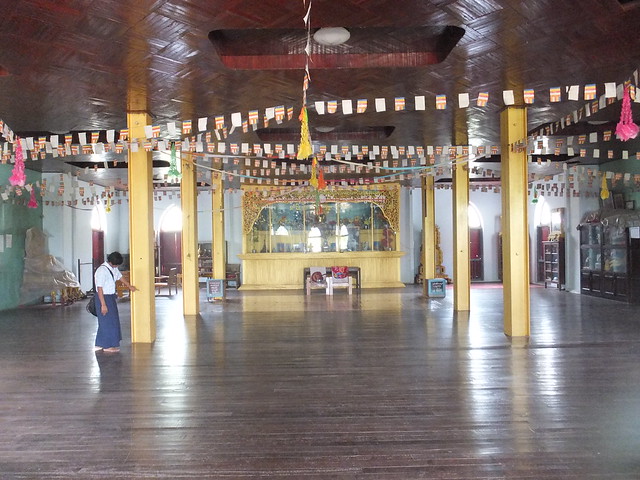 The ground floor of the Merchant's House.
The ground floor of the Merchant's House.
A wooden staircase led to the first floor. This was fitted with an ancient retractable lattice gate (like the gates on old-fashioned lifts) so that the upper floor could be closed off. Sections of Marsden Matting (the perforated steel planking designed in World War II for temporary roads and runways) had been adapted to 'box-in' the stairway. The first floor appeared to be empty, apart from a couple of men resting.
The Sittwe Temple
Next to the Merchant's House, there was a particularly exuberant building. Its design owed much to traditional Burmese monastery practice, but there were various European-influenced features, like arched windows and a clock tower.
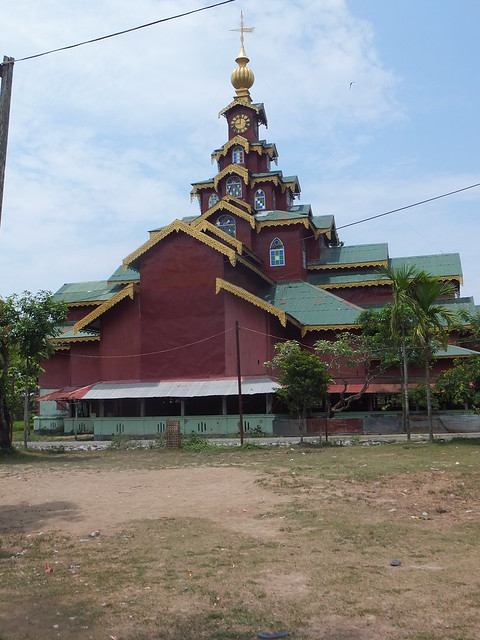 The Sittwe Temple.
The Sittwe Temple.
Entering the Temple, the main impression was one of size - the structure was huge, rivalling European cathedrals. This had been achieved by adopting steel framing throughout, with corrugated iron sheets for the various roof sections and wood for walls. No attempt had been made to disguise this construction and, somehow, this made the effect more breathraking. Four massive rolled steel columns supported the central tower and similar, smaller columns were provided for the other roof sections. At least one column was marked 'TATA IRON & STEEL'.
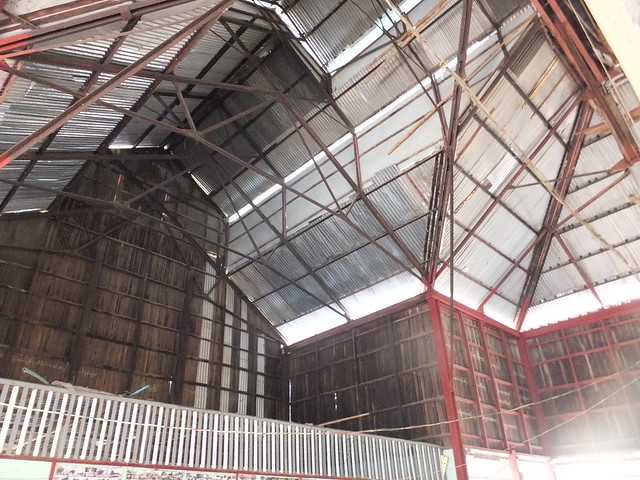 The complex roof is supported by numerous steel trusses.
The complex roof is supported by numerous steel trusses.
A large Buddha image occupied the centre of the tiled floor. Once again, there were various people sleeping on the floor.
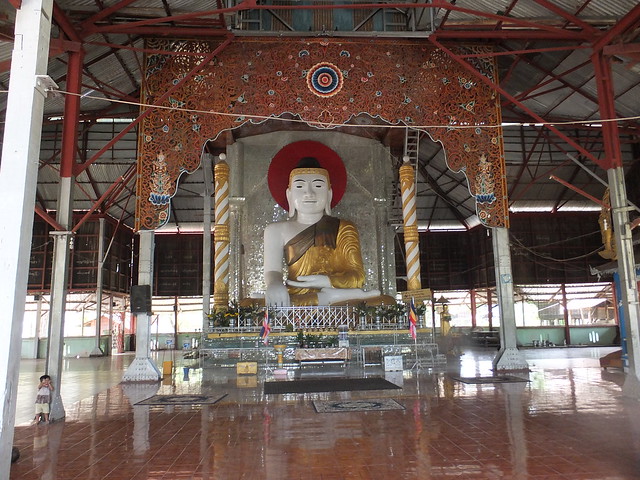 The Buddha image in the Sittwe temple.
The Buddha image in the Sittwe temple.
This wasn't the first time I'd seen a large steel framed building used for religious purposes in Burma. In November 2011, I visited Yangon's huge Reclining Buddha which is housed in a steel framed 'shed' as described in my post here (with more photographs here.
Bhaddanta Wannita Museum
Five minutes drive from the Sittwe Temple, we came to another Colonial-era residence which now serves as the Bhaddanta Wannita Museum. Bhaddanta Wannita was the head monk at the Maha Kuthala monastery and he collected the various artefacts which are now displayed here.
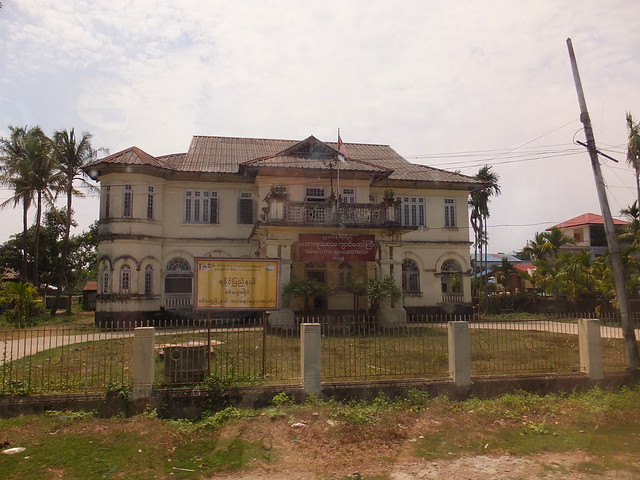 Bhaddanta Wannita Museum.
Bhaddanta Wannita Museum.
There was a large collection of Offering Bowls and Buddha Images but some of the items were more prosaic - smoking pipes and old currency, for instance.
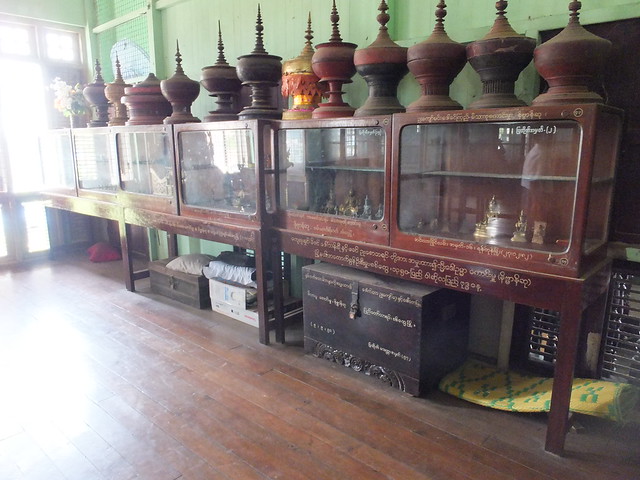 Offering Bowls and Buddha Images displayed at the museum.
Offering Bowls and Buddha Images displayed at the museum.
Sittwe Port Area
As we approached the port area, we could see two large cargo ships anchored offshore. There is only one decent jetty (made of reinforced concrete) where a larger ship can discharge and load. Otherwise, ships anchor in deeper water and use their derricks to transfer cargo to and from a smaller lighter which can moor at one of the quays.
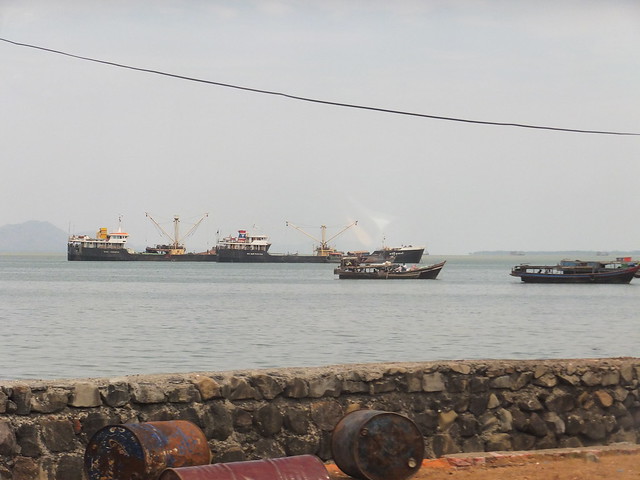 Cargo ships anchored offshore unloading and loading to lighters.
Cargo ships anchored offshore unloading and loading to lighters.
Near the quays there was a busy market. The narrow passages between stalls were also used by a number of porters shifting prodigious loads on massive and rather ancient 2-wheel trucks so it was necessary to keep a sharp lookout.
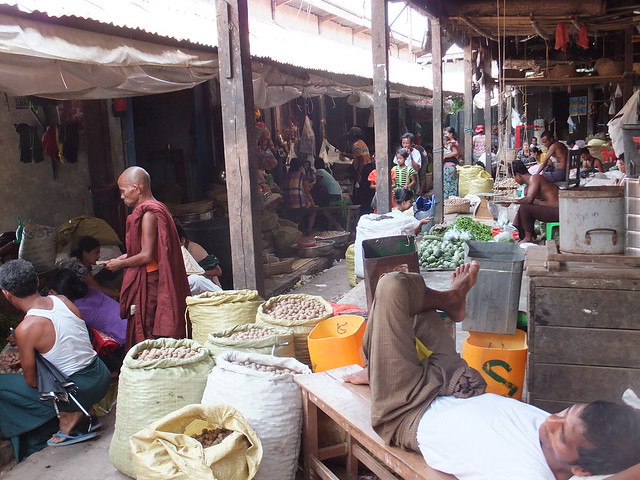 The Market at Sittwe.
The Market at Sittwe.
One part of the quay seemed to serve as a 'taxi-rank' for small boats ferrying people and goods around the Sittwe area.
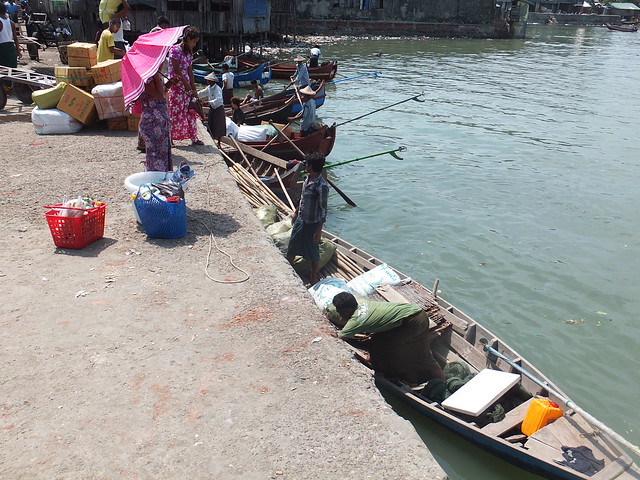 The quay used by small boats.
The quay used by small boats.
The small boat quay gave a good view of the numerous small boats criss-crossing the water and the single jetty where a cargo ship was berthed and able to discharge its load directly to trailers which were then hauled along the jetty by a tractor (I think the first tractor I'd seen on the trip - farm work is more usually done by animals).
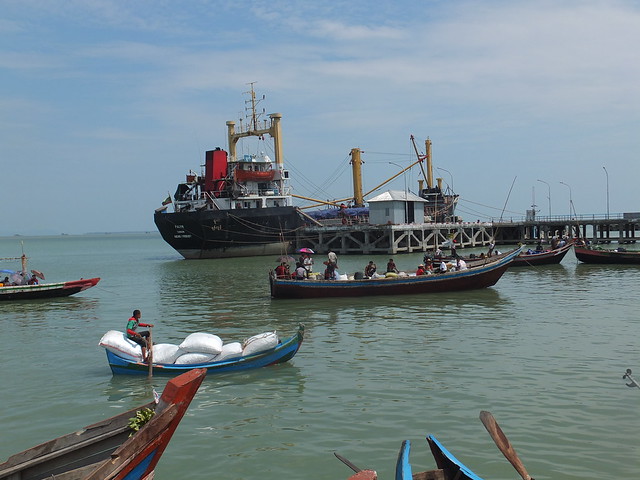 The busy scene near the Jetty.
The busy scene near the Jetty.
We continued our tour of the market, passing through the Fish Market to the area where large volumes of dried fish were being bagged and weighed prior to being exported to Bangladesh as animal feed. As we came back to the road, there were two ladies with treadle-operated sewing machines offering an 'instant repairs' service.
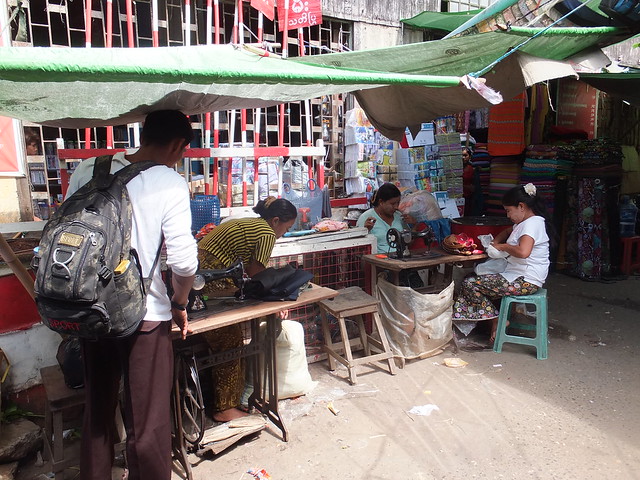 Clothing repairs while you wait.
Clothing repairs while you wait.
We rejoined our vehicle at a point where the map shows a second jetty which I failed to spot. I think this jetty is used exclusively by the Myanmar Navy, which operates a significant fleet. There's a list of vessels on Wikipedia here. We continued south past a large construction site next to the water. This is apparently a second commercial jetty being built by India.
Sittwe View Point
The road then turned into a modern promenade leading to a spit of land called View Point. I realised that this was the area I'd photographed from the air on my arrival at Sittwe.
 Sittwe's View Point area from the air.
Sittwe's View Point area from the air.
I'm sure the improvements carried out have made the area a popular destination for locals. The light house at View Point is a distinctive landmark and replaced a now-disused light house visible on a island just offshore. To the west, we could see View Point Beach stretching away.
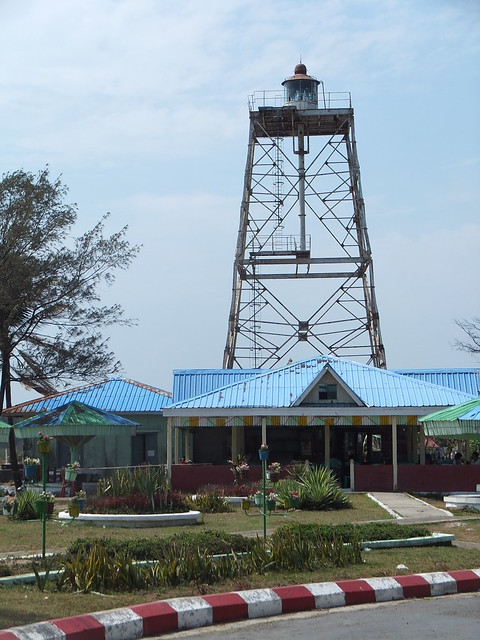
The Light House at Sittwe's View Point.
It only remained for us to drive back towards Sittwe, passing the British-built jail (still in use) and make our final stop at a modern pagoda.
Lawkar Nanda Pagoda
Construction of this pagoda only started in 1995 and the enshrining of Buddha relics took place in 1999. The main pagoda is surrounded by eight small satellite padodas. The upper part of the main pagoda was covered in woven bamboo 'scaffolding' to allow maintenance work (usually 're-gilding').
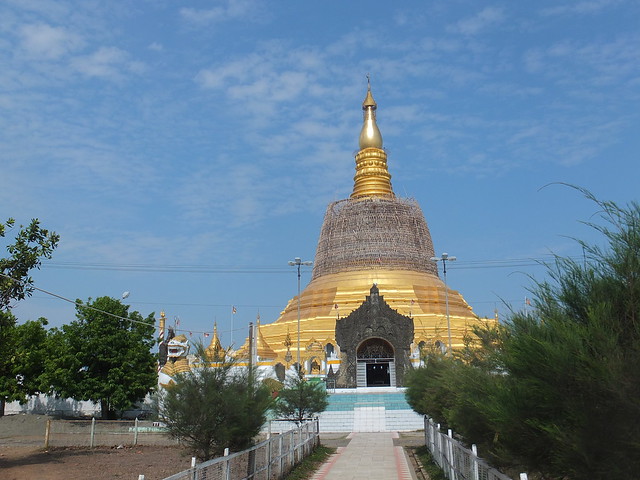 Lawkar Nanda Pagoda.
Lawkar Nanda Pagoda.
Nearby, we examined the Sakkramuni Image, now housed in a special chamber called Maha Wayyan Sasana Beikman. This is an ususual bronze Buddha image about 18 inches tall where the entire body is covered with small Buddha images. It was re-discovered at Mrauk U 14 years ago by a fisherman and is credited with "miraculous powers".
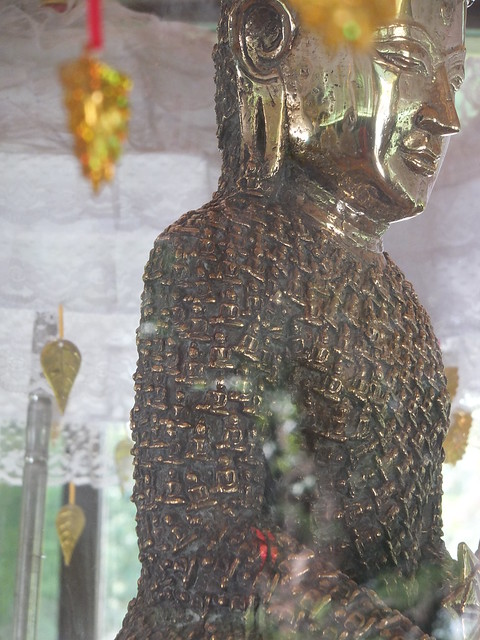
The Sakkramuni Image.
Sittwe Airport
We continued to the airport terminal building where the guide released the car. Check-in was quick and then the guide and I walked to the Airport Cafe (a couple of hundred yards away back along the approach road!) for a soft drink. Having said our 'goodbyes' after an absorbing three days, the guide made his way to relatives in Sittwe where he was going to spend the night before travelling back to his home in Mrauk U the following day.
I walked back to the airport and went through security into the departure lounge, to discover that my flight was running around an hour late. An 'Asian Wings' aircraft on the apron provided a small diversion. I'd been told it was awaiting technicians to carry out repairs. 'Aircraft On Ground' ('AOG') is a serious business and, whilst I waited, two mechanics opened the access cowlings on the starboard engine and, after carrying out some work, started the engine. Later, flight crew boarded the repaired 'Asian Wings' aircraft and carried out comprehensive power checks. By this time, my delayed 'Air KBZ' aircraft had landed so I was able to board for the direct flight back to Yangon.
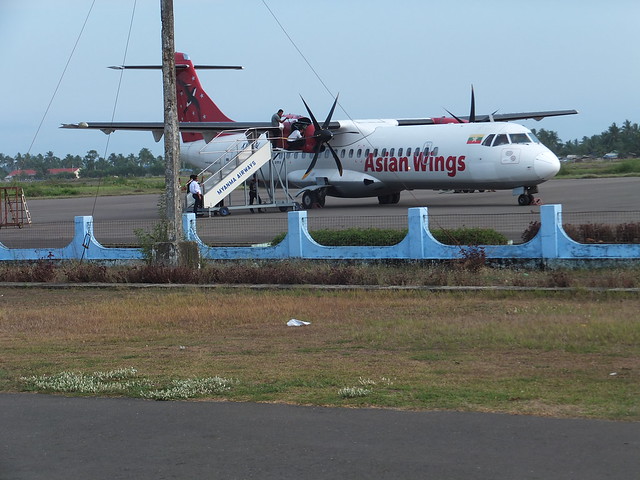 Mechanics working on the failed 'Asian Wings' aircraft.
Mechanics working on the failed 'Asian Wings' aircraft.
On arrival in Yangon, my usual friendly young driver was waiting for me outside the domestic terminal to transfer me to the Strand Hotel. It was dark and I noticed that the city now has many more illuminated advertising signs than on my first visit back in 2008. I suppose this is what we are pleased to call 'progress'.
I received the usual warm welcome at the Strand Hotel. This time, I was in room 107 on the first floor. After the exertions of the day, I slept well.
My Pictures
Sittwe, Myanmar.
The Merchant's House.
Sittwe Temple.
Lawkar Nanda Pagoda, Sittwe.
Sittway Airport, Myanmar.
Strand Hotel, Yangon.
More
Next Post describing this trip.
[Revised 9-Jun-2014]
